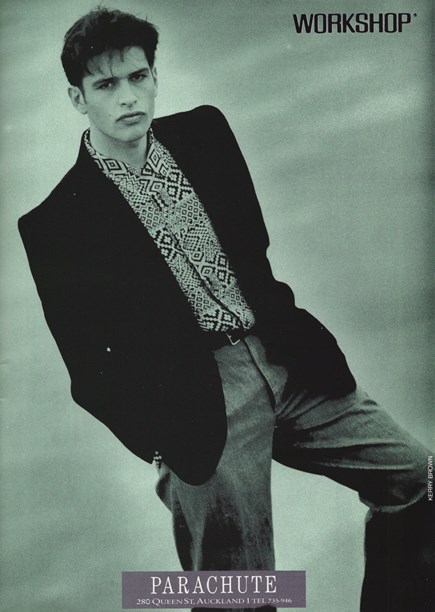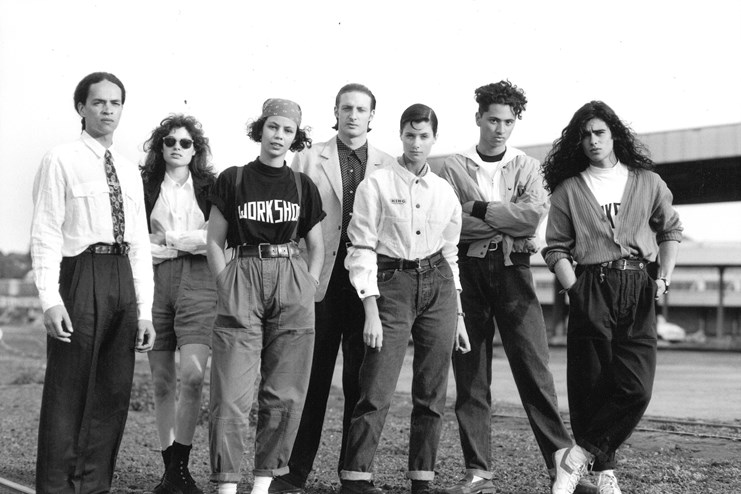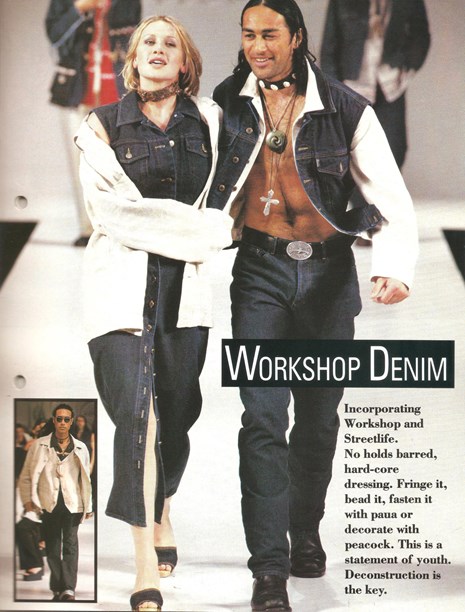Stories
Workshop
1982-

The Workshop brand emerged during a time when New Zealanders were becoming more aware of their identity as a Pacific nation. Set up as a complimentary label to Street Life, Workshop's advertising campaigns championed Auckland's cultural diversity.
Street Life was established in 1980 by Chris Cherry, June Robinson and Christine Moon who used the business name RCM. A second label, Workshop, was introduced two years later and sold from the Street Life store which had recently moved to High Street in Auckland.
While initially targeting women with their designs, Chris soon noticed that an increasing number of young men, interested in a more relaxed and nuanced style of dressing, were drawn to Workshop jumpsuits, army pants and shirts. In response Workshop produced clothes that refrained from being overtly gendered and this repositioned the brand as a street or urbanwear label, a relatively novel concept in New Zealand in the 1980s. An anorak, produced soon after this shift in focus and inspired by a real vintage American army coat Chris found whilst travelling in the Harajuku district of Japan, become a retail star. It became synonymous with the label and has been through countless iterations since.
Workshop's men's range was also sold in Parachute, a menswear shop located in Queen Street. Later, standalone Workshop stores were opened in Auckland in 1987 and Wellington in 1988.

Nigel Richard's store Parachute stocked early Workshop menswear. Image © Workshop.
Helen Grbic (later Helen Cherry after she and Chris married) joined RCM in 1986 to take over the design of the Street Life label after Christine and June left the business. With Chris focusing on Workshop, the two RCM labels were able to develop independently.
The Japanese aesthetic embodied by designers Rei Kawakubo and Yohji Yamamoto had a huge impact on the Workshop look and was the inspiration behind Chris’ early attraction to natural fibres and fabrics. Hand dyed or raw linen, drill and denim was hard to source in Auckland in the 1980s until Chris befriended textiles importer Roger Wall who provided him with fabrics, some used by the Japanese designers themselves. These natural fabrics inspired a quintessential Workshop garment, the oversized linen shirt, worn by both men and women.

Workshop photoshoot, 1980s. Photo by Kerry Brown. Image © Kerry Brown.
The natural textiles lent themselves to screen printing. The label's early designs, logos, and shop interiors borrowed regional imagery and the expertise of local visual artists. The patterning, usually commissioned from local artists, gave Workshop garments a distinctive edge within the local market. A tuatara and weta motif was an early print designed by Ngila Dickson and a stylised pacific border was based on a print by John Pule.
Later, when t-shirts were incorporated into the Workshop collection, John Reynolds made a number of designs of which 'Ta ra ra boom decay' was the most politically charged acting as a protest against nuclear bomb testing at the Mururoa Atoll. Other artists who have worked with the brand include Rosanna Raymonde, Paul Hartigan, Luise Fong, John Reynolds. Kerry Brown's campaign photographs were ground-breaking for their representation of the diversity of Auckland. Artistic partnerships continue to be significant in the development and extension of the Workshop aesthetic providing a visual language of place.
Workshop fashion shows operate as vehicles of aesthetic and philosophic communication and the Cherrys have purposefully nurtured this by refraining from participating in shows where they didn’t have artistic control.
The 1993 Corbans Fashion Collections allowed them final say on both choreography and selection of models. "Up until then fashion shows had cued music and … models who would come out again and again. Instead we just launched all these models … at the same time" says Chris. The catwalk was a mélange of customers and friends, professional and inexperienced models, and contemporary dancers.
It was at this event that the diffusion range Workshop Denim also made its debut. The ethos of the new denim line was suburban and raw and it has become a cornerstone of the Workshop brand. Having seen the denim woven on antique shuttle looms in Kaihara, Japan, Chris wanted to fused that with a New Zealandness that made Workshop Denim idiosyncratic and locally useful. "We found ourselves asking: what are our jeans? They are not an American thing, they are not a ‘50s thing, they’re not that 19th century gold-mining thing, we are a New Zealand, a Pacific thing."

Workshop Denim was launched at the 1993 Corbans Fashion Collections.
The Workshop menswear show at the 1998 Mercedes-Benz Australian Fashion Week was similarly distinctive and incorporated tā moko commissioned from the Māori tātau artist Te Rangitu Netana. The soundtrack of live Pacific drumming reinforced a cohesive and sophisticated response to the designs and by extension the locale of origin. More recently in 2014 the show included actual artwork by its collaborators. New York-based artist Max Gimblett and Napier painter Martin Poppelwell worked together on ceramics which were used as inspiration for the decoration on the Workshop clothing, some of which was directly hand-painted. In celebration of the artists and the uniqueness of the project Max Gimblett’s skull and quatrefoil prints were available for sale at the gala night, showcasing the artistic progression from inspiration to execution.
The local currency of the Workshop aesthetic has had great strength in the New Zealand retail market. After a brief foray into the American market via New York and the Australian market (which saw the Cherrys battle legal difficulties because of naming rights), the Cherrys decided to focus their attention on national expansion.
Instead of chasing a fluctuating overseas market in the 2000s, they invested in large and impressive Workshop stores in Morrow Street, Newmarket and later MacKelvie Street, Ponsonby. They also relocated their Wellington and Christchurch stores and Workshop retailing took off. "Our strength is retailing," says Helen, "it’s what we do best … our brands are strong, we have fantastic imports, let’s just stick to our knitting."
Supported by a loyal clientele, Workshop remains a key figure in New Zealand’s fashion history. The Cherrys combined skill-set together with a commitment to quality of design has enabled them to work to the tune of their own song. With a focus on quality of "cut, cloth and construction", Workshop designs are classic yet fresh, and their wearability enduring.
Text by Alice Tyler. Banner image of Helen and Chris Cherry by Kerry Brown. Image © Kerry Brown.
Last published November 2016.